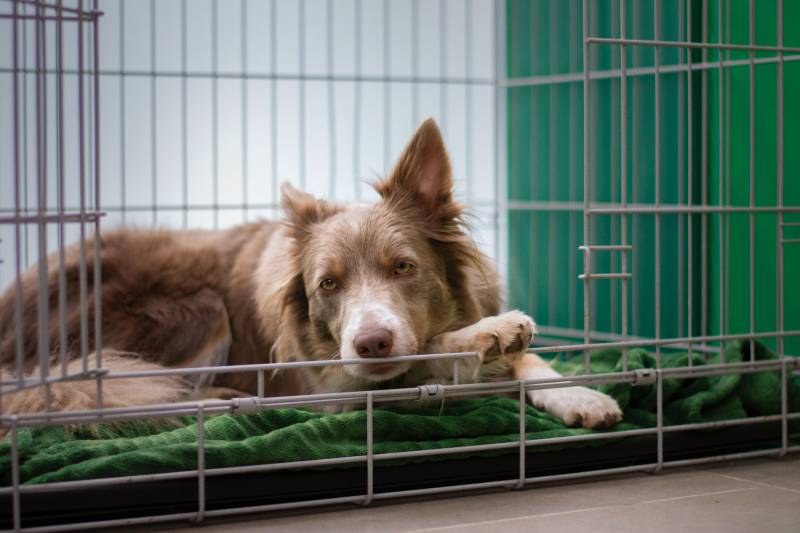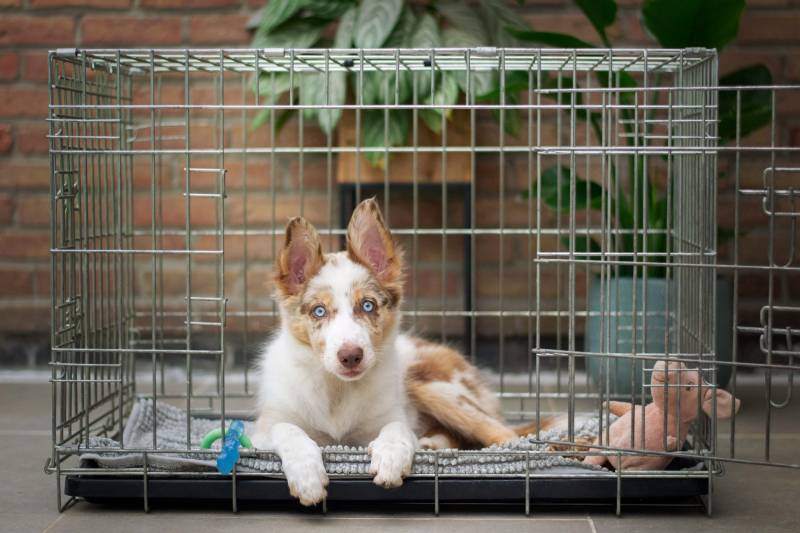Quick Navigation
As a dog owner, you may ponder where the best place for your pup to sleep is.
You must have read articles and watched videos on where the best place is but one stood out, which is the crate.
You need to be sure if the crate is the best place or if it’s a good idea for your furry companion to sleep in the crate, especially at night.

Dogs love to sleep; it takes up about half of their day.
In a day, an adult dog sleeps for 13 hours while puppies nap for about 18 hours.
They must have a good and cozy place to carry out this activity.
Why Your Dog Should Sleep In A Crate?
- Crates are essential and useful tools for dogs and their owners. Your furry friends can have a place to settle in and have their cozy naps.
- It also protects the pup from danger when you are not around. If your dog sleeps on the bed with you and you worry that you might roll over them. The crate is the best place for your canine to sleep overnight.
- Dogs do not like to ease themselves in the same place they sleep. So crate training your dogs helps them control their bowel and bladder. When your dogs sleep in a crate, it helps them sleep for long hours. It gives them a feeling of a haven.
- Dogs like to mark their territory; they instinctively have a den, their personal space. Getting your dog or puppy to sleep in a crate can be difficult, especially when introducing it.
Crate training your pup will be an excellent idea, to begin with.
If you have a younger pup that likes to roam the house in the middle of the night to amuse themselves, then they should be kept in crates.
If you introduce a crate to a pup at a tender age, they see the crate as their peaceful place.
A place they can rest after chasing and running around the house.
Many dog owners worry about the comfort of their dogs.
They aren’t sure if their dogs will stay in their crates because they are social animals.
Don’t worry; they don’t have a problem staying in a crate, especially when their social needs aren’t affected.
Dogs who aren’t house trained should also be kept in crates and should definitely not be allowed to sleep in your bed as you could wake up to an awful accident in the middle of the night.
How Long Should I Crate My Dog Last?
You can crate your dog for up to half the day or even overnight.
But, how much time can you safely keep a dog in a crate?
No more than 6 to 8 hours should be spent with adult dogs in crates.
Puppies who are 17 weeks old and older can tolerate up to 4 or 5 hours per session in a crate.
Make sure you provide for their physical and social needs when they are outside the crate.
Dogs love to play and socialize with other dogs.
You must take them for walks when they are not sleeping or resting.
Allow them to play and socialize with other dogs before they go back to their personal space.
A dog’s physical and mental health may suffer if they are kept in a crate at home for an extended period of time.
So, whenever you decide to keep your dog in a crate, it is always important to train them.
Depending on your dog’s age, temperament, and previous experiences, crate training can take days or weeks.
When training your dog in a crate, it’s important to keep two things in mind: always associate the crate with something enjoyable, and break up the training into manageable chunks.
How To Train Your Dog To Sleep In Their Crate?
It is easy to introduce crates to your puppies than adult dogs that have never been crate trained.
Take it slowly.
- You can crate train your puppy by tossing their food-stuffed toys inside the crate when they are inside.
- With time, they would walk into the crate, hoping to get a chew toy thrown in.
- Place the crate where they can be free to stroll in and out until they are comfortable.
- The best way to crate train an adult dog is to lock their dinner inside the crate and lock it. You should allow them to struggle to get to their food before opening the crate. You can likewise work with a dog trainer to help devise the best method for crate training your dog.
- Never reward their barking. When they see you come around when they bark, they see it as a mechanism to get you to open the crate.
- Never leave your crate-trained puppy in the crate for a long time. They may feel abandoned or depressed.
- A crate-trained dog stays calm in its crate when you need to travel for long hours or visit the veterinarian. It isn’t worrying because it knows it is safe. They get this sense of safety and comfort.
When getting a crate, one rule of thumb is to buy a crate big enough for them to stand and move around a little.
It would help if you lay thick clothes inside the crate so that it’s cozy for them.
Crates should never be a form of punishment or detention for your dog or puppy but should be a place of comfort.

Why The Crate Is A Good Idea?
- One of the benefits of a crate is you don’t have to worry about your dog’s safety when you are not around. If your dog stirs a lot, you are sure it is well contained in its crate.
- The crate is an excellent choice when you are house training or potty training your dog. They wouldn’t want to mess up their space. So it helps them control their bladder and bowel.
- The crate serves as a secure cave for dogs. During rainfall and thunderstorm, dogs see their crates as a safe zone. They see it as a safe spot.
- It serves as a quiet and calm place for your dog or puppy when every other place seems noisy.
- It serves as both the dog’s bed and haven. For safety, the dog’s security, housebreaking, stopping destructive behavior, and/or traveling, it serves as a place of confinement.
A crate is a training tool because it prevents your dogs from chewing on things around the house.
It’s important to consider the size when choosing a crate for your dog.
Your dog should be able to stand up and turn around inside the crate without restrictions.
Choose a crate size that will accommodate your dog’s adult size if they are still growing.
Crates may be available for rent at your local animal shelter.
Until your puppy reaches adult size, you can rent a crate that is the right size for them until you can buy a permanent crate.
Crates are available in a variety of sizes from most pet supply stores or online.
Some are expandable as your dog gets bigger, which is great for young dogs.
Precautions Of Crating
Pet owners need to know that crates aren’t magical tools used to correct dogs’ misbehaviors.
Crates should serve as a haven for dogs, and they should feel at peace when they are in their crate.
- You must never lock up your dog in the crate with toys to prevent them from misbehaving. You should entice your dog into the crate with chew toys until they are comfortable moving in and out of the crate independently.
- You should place crates in any part of the house where people spend most of their time. It gives them a sense of belonging.
- You should never lock up your dog for a whole day without exercising or socializing with other dogs. They may end up being anxious and depressed.
- Puppies under six months cannot control their bladder or bowel. They should never crate them for more than three hours. You must never crate your house-trained adult dog for a long time too.
- You must crate your dog when you are not around, so they don’t cause accidents or damage things in the house. Most, of your furry companions, should never spend most of the day in the crate. A dog sitter is useful during this time.
Dog Sleeping In A Crate At Night? Is This A Good Idea?
Yes, it is a good idea. Most dogs love to stay in their crate. A crate-trained dog would enjoy sleeping in its crate at night.
If your dog or puppy is well-trained, you can leave the crate door open for it to walk in and go out as it pleases.
If you crate your dog the whole night, it will do your dog a lot of good if you take them for a walk in the daytime.
A crate-trained dog or puppy is a well-behaved pet.
They can go into their crate when their environment seems overwhelming.
It also builds the bond between you and your furry companion.

Lucy is a real-time contributor to Purrfect n’ Pawesome, along with being a freelance writer to various pet forums and platforms. She started writing professionally in the year 2016. Earlier, she enjoyed her community life as a pet rescue volunteer and offered boarding services to pet owners. Her extensive experience in the pet field is now the basis for her writing at this site.
She loves to collect animal facts from around the globe and then transform them into amazing stories for her readers. For Lucy, the mission is to bring pet love to every home and equip the pet parents with the required useful and authentic information to nurture their pet accordingly.
She lives with her two cats and a shepherd mix, whom she loves the most. Despite her extremely busy life, she spends some time with wildlife and outer space to relax her mind and enhance her observation.
Purrfect n’ Pawesome is a platform that believes in providing our pets with the right kind of nurturing, care and upbringing to assist them in leading a healthy life. Go to our blog section and read out some pawesome and informative articles to ease your parenthood.




![Why Do Geese Honk At Night? [8 Reasons] Why Do Geese Honk At Night? [8 Reasons]](https://purrfectnpawesome.com/wp-content/uploads/2021/08/Why-do-geese-honk-at-night-150x150.jpg)

